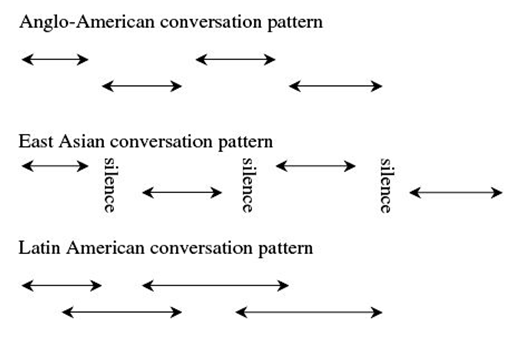Last month, I did a cross-cultural conflict management workshop for the Inter-Cultural Association of Greater Victoria. The participants were all immigrants. Their time in Canada ranged from weeks to years. The content focus was the workplace and employment.
Culture and conversation patterns
One of the concepts I touched on dealt on was cultural differences in conversation flow. I used this image:
The image is based on a similar one, by Lionel Laroche, in his book, Recruiting Retaining and Promoting Culturally Different Employees.
I used this image to help frame discussion around cultural differences, and how are habits are largely influenced by the culture we grew up in. Since the workshop, I’ve been ruminating on how the cross-culture conversations also raises some questions on another front…
Culture and technology
What happens when we are interacting with people from diverse cultures, online? What role does technology play on cross-cultural conversations?
On one hand, if we take asynchronous channels, such as email or text, technology, conversations tend to happen serially, with spaces in-between messages; with exceptions – e.g., the dynamic forums such as a high-traffic Twitter chat. Technology is a culture leveler.
On the other hand, with synchronous communications; such as with audio and video channels, cultural patterns can largely be maintained.
If I intentionally choose asynchronous channels, I reduce potential cultural differences, and by association, diversity. Generally, diversity is a good thing, especially in problem-solving mode. Paradox.
If I opt for synchronous channels, I maintain cultural differences and diversity; assuming there is no lag in data transmission. If there is a lag, which is not uncommon, especially where bandwidth issues occur, then even video can be a culture killer.
Either way, technology, more or less, can hide culture differences.
Yet, those cultural differences don’t go away. People carry them wherever they go. They are one of our gifts, a strength to be drawn on. Diversity is good.
The big question
Bottom line question…how do we maintain cultural diversity in our virtual conversations; in our role as conversation choreographers, community facilitators, and as believers in diversity?
While not focused on virtual, I think orienting to people’s gifts might be a good place to start. Community Activators offers 20 Things You Can Do When You Know Someone’s Gift. And, on the virtual front, here’s some thoughts from language translator Christian Arno around cross-cultural social media.
And you?
Does your virtual work involve interacting with people from different cultures? If yes, how do you bring out their gifts, sustain diversity…?


Hi Ben, I do think also in asynchronous communication mis-communication due to cultural differences can occur – since we interpret from our own frame of mind… cheers, joitske
Definitely, Joitske. No shortage of opportunities to mis-communicate. 🙁 It’s almost as if we have to find some common ground on our cultural differences before addressing the technology-based challenges of virtual communications. Thanks for checking in.